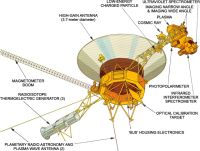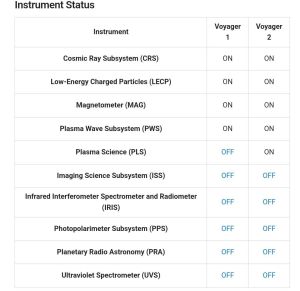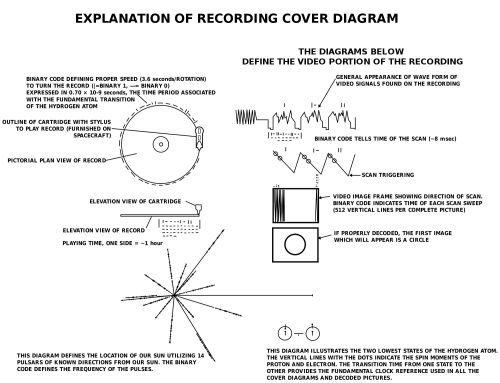b l o g g i n s p a c e wiki
Voyager 1 & Voyager 2
Two of the coolest things that mankind has ever done (if you believe in space) that will probably outlive man himself. Voyager 1 & Voyager 2 are 2 space probes that were launched back in the 1970s when somebody figured out that Saturn, Jupiter, Uranus and Neptune were all going to be lined up in a strategic manner. Both probes have been flying ever since.
History
NASA is not the best, most honest, source for scientific information,[1][2][3][4] but here is what they say about the two probes:[5]
The twin spacecraft Voyager 1 and Voyager 2 were launched by NASA in separate months in the summer of 1977 from Cape Canaveral, Florida. As originally designed, the Voyagers were to conduct closeup studies of Jupiter and Saturn, Saturn's rings, and the larger moons of the two planets.
To accomplish their two-planet mission, the spacecraft were built to last five years. But as the mission went on, and with the successful achievement of all its objectives, the additional flybys of the two outermost giant planets, Uranus and Neptune, proved possible -- and irresistible to mission scientists and engineers at the Voyagers' home at the Jet Propulsion Laboratory in Pasadena, California.
News And Stats
Both Voyager 1 and Voyager 2 have been in the news a lot lately. Of course they are, mostly because the earth is speedily creeping toward World War 3 while at the same time learning that aliens are behind it all. But (if you believe in space) Voyager 1 and 2 both keep chugging along.
While they keep speeding themselves from Earth, they are starting to run into problems. Since at this distance, it takes around 2 days to send information and receive information from them,[6] a lot of things can happen and a lot of things seem to be going wrong. That's okay, when was the last time you had anything last over 47 years?
Information below is current as of 4-21-24.
Voyager 1
Launch Date: Mon, 05 Sept 1977 12:56:00 UTC
Mission Elapsed Time: 47 Years, 7 Months, 15 Days
Distance from Earth:
- 15,070,857,162 miles
- 162.7 AU (Astronomical Units = 92,955,807.3 miles)
Estimated Velocity: 38,000 mph. The speed fluctuates a bit, but that is close to the average.
Voyager 2
Launch Date: Sat, 20 Aug 1977 14:29:00 UTC
Mission Elapsed Time: 48 Years, 8 Months, 1 Day
Distance from Earth:
- 12,660,058 miles
- 136.2 AU (Astronomical Units = 92,955,807.3 miles)
Estimated Velocity: 34,390 mph. The speed fluctuates a bit, but that is close to the average.
Image

Message For Potential Conquerors
![]() "This is a present from a small distant world, a token of our sounds, our science, our images, our music, our thoughts and our feelings. We are attempting to survive our time so we may live into yours"[7] - Jimmy "Horse-Toothed Jackass" Carter
"This is a present from a small distant world, a token of our sounds, our science, our images, our music, our thoughts and our feelings. We are attempting to survive our time so we may live into yours"[7] - Jimmy "Horse-Toothed Jackass" Carter ![]()
Smart guy scientists included an "interstellar time capsule" on board of both probes. Basically, they sent a bunch of pictures, songs, and other assorted crap out into space, letting everybody know just what sort of dumbasses we are.
Some of the images show people eating and drinking water, clueing in any potential invader on humankind's top two weaknesses. All of this is detailed on the Golden Record, where the stupidity keeps flowing...
Golden Record
If you were an alien species that wanted to find and conquer somebody stupid, it would be really helpful if you had a set of directions. Fortunately, humankind has provided just such a thing. On the "Golden Record" that is affixed to the Voyager probes, smart guy scientists thought it would a great idea to show the location of the Earth in relation to 14 pulsars that were known at the time.
Here it was where our own stupidity might have saved us. At the time of the creation of the Golden Records, smart guy scientists only knew of the existence of 14 pulsars and thought that they were really rare. Years later we launched a bunch of telescopes and found out that it wasn't the case. There are a shitload of pulsars out there and hopefully the sheer number of them will obscure our stupid directions left on the probes.
Not only that, but back in the 1970s, scientists only charted the 14 pulsars that would point their directed energy towards the Earth, not knowing that pulsars don't always point at the Earth. Fast forward a few decades and it turns out pulsars tend to move and some of them even vanish!
So we got that going for us.
What's Going On Now
So we know that Voyager 1 and Voyager 2 are pushing the limits of our solar system. As great as they are, they are starting to wear out. Since November 2023, NASA's Voyager 1 spacecraft has been sending a steady radio signal to Earth, but the signal does not contain usable data.
Voyager 1 seems to have some corrupt memory. The way to fix this was to actually hit the spacecraft just like you would hit a television that was acting up. The Jet Propulsion Lab guys did this by sending a "poke" message to the probe that woke it up long enough to send some data about the computer's software.
After looking at the data, the JPL guys figured out that a chip was busted, preventing onboard systems from carrying out normal operations. They don't know why, but they have narrowed the cause down to two things: a particle hit the chip, or, the chip is 46 years old and is finally wearing out.
Super smart science type guys think that they will eventually figure out a way to re-route the probe's hardware and it will start sending good data once again.
Even still, most of the people behind the project think (and say) that the whole thing will end in 2030.[8]
See Also
References
- ↑ https://www.ndtv.com/offbeat/why-all-images-of-space-are-photoshopped-2048113
- ↑ https://www.forbes.com/sites/jamiecartereurope/2022/07/18/yes-nasa-did-manipulate-the-webb-telescopes-first-color-images-last-week/?sh=201dd0c3e41a
- ↑ https://www.usatoday.com/story/news/factcheck/2022/11/16/fact-check-image-mars-rover-digital-rendering-not-photograph/8255914001/
- ↑ I am not going to get into how the Apollo Missions were faked here. Go google the info yourself.
- ↑ Voyager FAQ
- ↑ A little more than 20 hours each way for over 40 hours roundtrip.
- ↑ https://www.businessinsider.com/voyager-spacecraft-carry-golden-records-explain-earth-to-aliens-2022-6
- ↑ https://mashable.com/article/voyager-nasa-how-long-will-mission-last
• The Moon • The Science • Green Leaf Volatiles • EGF & Foreskin Cosmetics • Panpsychism • The Scoville UNIT • Microwave Oven • Heaven's Gate • Timelines • Red Maps • The SPARS Pandemic 2025-2028 • Leidenfrost Effect • A Screwdriver • Euler's Disk • Roko's Basilisk • Worlds In Collision • Uranus • ChatGPT Phrases • DignifAI • Soft Water • Blue Seven • Voyager 1 & Voyager 2 • 52 Factorial • Ramirez • Elections • Termux •




